Enter: Solid-State Electronics
on

Examining the DIY electronics scene in the 1960s by browsing pages from old electronics magazines — both pro and hobbyist — you can’t help noticing a sweeping movement going during those years and causing much controversy: the initially gradual, then torrential influx of the transistor, dethroning the vacuum tube as the active element having ruled the scene for over 50 years. When Elektor was born as Electronica wereld back in '61, the tube filament still glowed but it faded as the sixties got on steam.
Early Elektor
Electronica wereld (shorthand E w; in English: electronics world) was the forerunner of the Dutch Elektuur, later named Elektor and going international in many languages. Having grown up with Radio Bulletin — a direct competitor of Elektuur and a much older publication come to that — I did not start reading Elektuur until 1982 or thereabouts, and then only the “Summer Circuits” editions I could afford to buy as a student and having to travel 30 miles on a bus to get my copy. Until this day, I had never taken much interest in reading very early Elektuur/Elektor stuff and I was only vaguely aware of the magazine’s rather “wild” origins in Amsterdam during the cold war and hippie years when electronics boomed in Europe.
Picking a random 1960s copy of E w, the first thing that struck me was the strong, argumentative writing style mostly by founder and one-man-band, Bob W. van der Horst out of his home in Amsterdam. The contention and debate sensed in his little pamphlet (which he delivered personally, on a bicycle, to his Amsterdam area subscribers) often involved classic electronics versus modern stuff. Not surprisingly, this meant: the established vacuum tube versus the newcomer, the transistor.

Browsing these old pages, it’s hard to deny van der Horst’s predilection for modern if not avant-garde technology. However, he does tread carefully and succeeds in creating a great divide between “hollow-state” and “solid-state” technology, as doing so would fail to get his magazine off the ground.
If you can read Dutch, you’ll find that van der Horst and his early team of writers expressed things in an extremely popular manner compared to the established, highbrow competitors in Holland like Radio Bulletin and Electronica. This is limited to his editorial piece and the construction articles though — the reports on developments in the electronics industry and research have a more formal tone, clearly echoing the manufacturers’ press bureaus and overseas (mainly English and American) journals, including ham radio publications like those of the ARRL (US) and the RSGB (UK). With hindsight, many E w articles were rough-'n-ready at best, abounding with open ends and plain errors, yet coaxing hard to experimentation and improvement by an audience with a critical stance to traditional electronics straight from the textbooks and heavily tube-dominated.
To substantiate and illustrate the above points, as well as honor Bob van der Horst’s truly pioneering and audacious spirit, what better way than to show a few instances fairly randomly taken from Elektor’s earliest, Dutch-only, publication decade, 1961-1969?
Beating the Tubed Distributed Amplifier?
The 1962-9 issue of E w contained an article on the first, rather vague, ideas on installing “wired TV” (i.e. cable TV) in The Hague. The system was named CAS for central antenna system. The early experiments were headed by the Dutch Post and Telegraph Authority (PTT). The obvious bottleneck was the attenuation of wideband RF signals on a good 25 kms of overhead coax cable needed to connect around 5000 subscribers. The distributed amplifier with tubes seemed a good candidate to solve the problem, as the DA offers (1) a high gain-bandwidth (GBW) product; (2) sufficient GBW even if one tube fails; (3) low radiation; and (4) low cross-modulation. The PTT’s plan was to install one DA for every five subscribers — Dutch tube suppliers and retailers must have rubbed their hands in glee!
Why the DA? As an example, the total gain of a DA is 16 for 4 tubes giving a gain of 4 each. Even if the tubes attenuate at, say, G = 0.8, then the overall gain is still 4 × 0.8 = 3.2, which sets the DA apart from a “conventional amplifier”.
The article closes with the well-argued note that transistorized DAs are likely to beat the tube approach soon, as transistors (1) can be powered by the (low) voltage available on the telephone line; and (2) offer a longer lifespan than their vacuum predecessors. Nothing is said about the frequency range, cost, or vulnerability to voltage surges of the relatively new-fangled semiconductors.
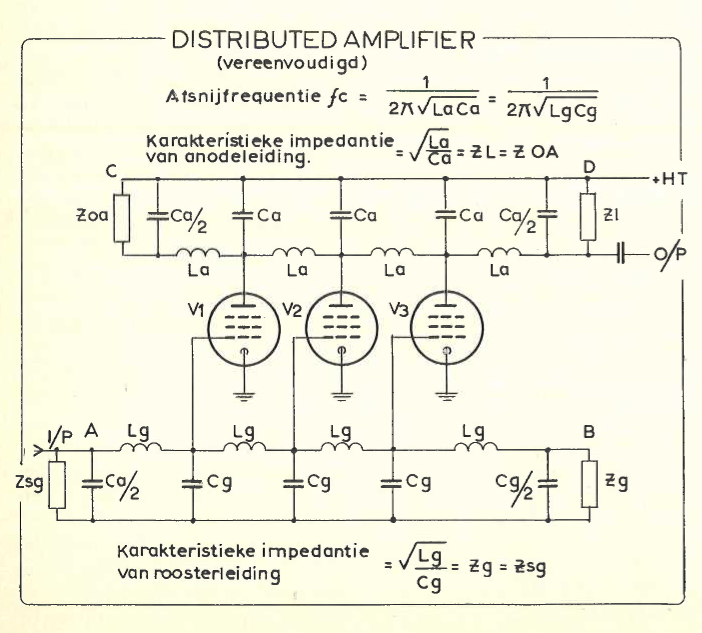
Single-Tube Walkie-Talkie
From E w 1962-6 comes this “sketch” for a walkie-talkie for the 2-meter (144 MHz) radio amateur band. Interestingly, the article opens by saying that "similar designs with transistors have failed". How, when and why isn’t clear.
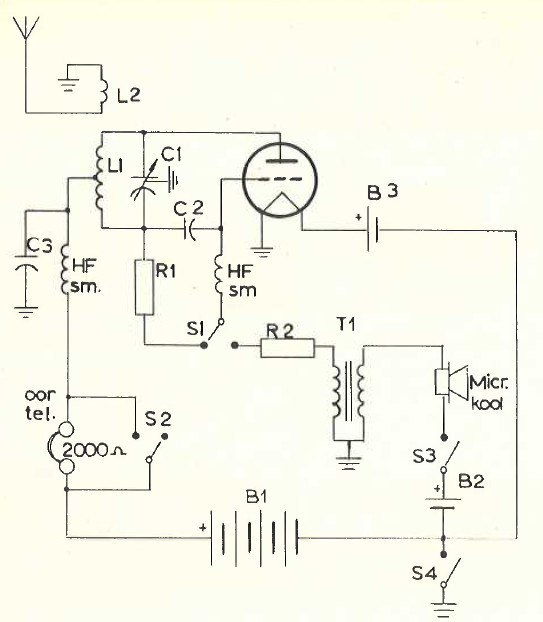
The tube suggested by E w is a “professional” type 5676 from Telefunken (also a leading advertiser in the magazine…). The 5676 alone is said to cost “just HFL 7,50” which was about three weeks’ pocket money for an average youth in Holland back in 1962. But hey, this was a “pro” tube with direct heating and extremely low microphonics!
The design is minimalist with a 90-V or a 135-V battery for the plate voltage (B1) and two more batteries, B2 (9 V) and B3 (1.5 V) for the carbon microphone bias and filament supply respectively. In ‘listen’ mode, the 5676 tube acts in super-regenerative mode. The walkie-talkie is claimed to cover about 3 kms with a 135-V battery. In transmit mode, it’s no more than a free-running oscillator with some modulation applied.
The construction drawing shows a clever trick for the push-to-talk switch — can you discover it?
I can’t imagine any fellow hams and other users of the 144 MHz amateur band being appreciative of any communication going on between a pair of these walkie-talkies in their neighborhood. The stability, spurious radiation, and AM/FM mixed modulation must have been awful and enough to obliterate DX stations. Still, the project shows what can be achieved with just one Telefunken tube!
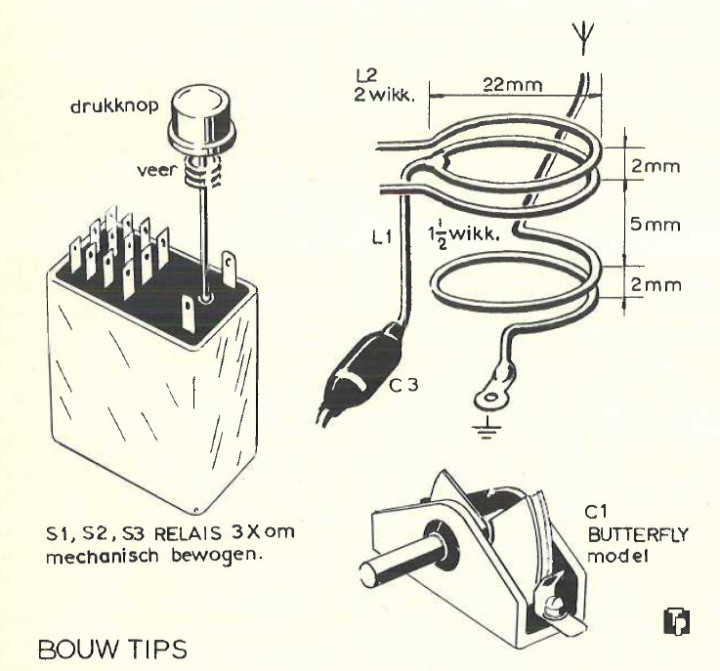
Poor(est) Man’s Voltage Discriminator
Well before the famous Summer Circuits appeared in Elektor, E w had the knack of publishing ”stop-gap” articles genuinely intended to fill pages at the corners. Haters and lovers of these “electronics telegrams” were divided 50/50 well into the Summer Circuits publication period, which ended around 2015.
Back to 1963, two neon tubes are connected as two arms of a bridge circuit, the other arms being resistors. The circuit will not pass the input voltage until a certain level is exceeded. That level — we learn — is defined with “R“. Calculations for R and hysteresis? Those are for you to find out.
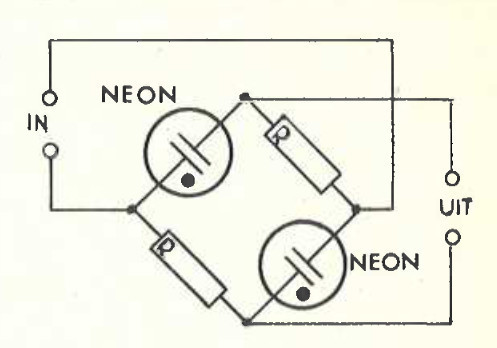
Transistor PDM Amplifier
Named Elektuur rather than Electronica wereld, the May 1965 edition was choc-a-bloc with a huge overview and comparison of commercial oscilloscopes on the market, covering dozens of pages. Although the overview goes to great lengths to emphasize the importance and dominance of transistors in the instruments tested, it cannot bely the presence of at least one tube in all ‘scopes — the CRT. In some “pro” scopes, tubes also ruled the high voltage section.
And so, as we reach the mid 60’s in Elektuur and the transistor appears dominant in the articles, the tube remains a skeleton in the cupboard, even if for comparative purposes only. Consider the large article on a 10-watt PDM (pulse duration modulation) amplifier in the 1965-5 issue. PDM amps have a long legacy of tube tech, but here we learn that a semiconductor version can be built that’s almost hi-fi yet lightweight because it has no heatsinks! The crux as we all know by now is that transistors, compared to tubes, are (almost) ideal switches, and that fact is extolled and fully exploited in a revolutionary design back then.
Some transistors suggested in the parts list, like the BFY40, were silicon and “fast & oddball” for E w readers at that time. Fortunately, most of the other “trannies” in the project were the good old AC12x and the (Dutch-developed!) OC7x / OC17x germanium types, besides some 2SAxx’s from Japan. In later years, Elektor was notorious for its stubborn use of oddball components.
The article closes with an outlook on motional feedback, a principle exploited by Philips a few years later with their iconic “MFB” loudspeakers with their characteristic internal amplifier. Incidentally, Elektor in the mid-70s and early 80s published its own versions of MFB, with great success too.
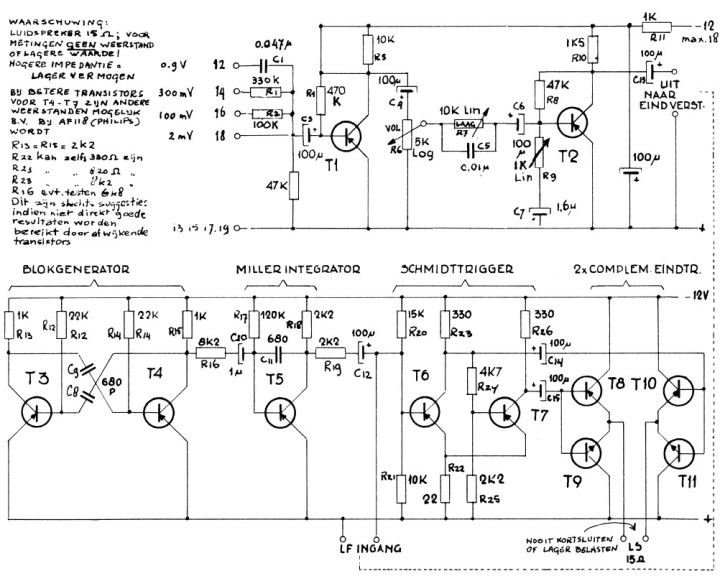
Tube/Transistor Hybrids (Pt.1)
Although their respective fans often proclaim to hate each other, tubes and transistors can be mixed in one circuit and yield perfect results. Just look in a 1960’s Tektronix oscilloscope or even a 1980s guitar amp and you’ll find some really perfect “hybrids” giving the best of both worlds.
When audio purists want a clean, stable direct voltage on their tube filaments rather than “some AC”, a germanium transistor may be the ticket. As a page filler project, E w issue 1962-9 suggests a big fat 2N555 power transistor held in check by a Zener diode to ensure a pristine 6.3 VDC supply voltage for one or more tube filaments drawing up to 1.2 amps in total. You’ll recall that power germanium transistors drop a mere 0.15-0.2 V when fully biased, won’t you?

Tube/Transistor Hybrids (Pt.2)
Audio proved to be a fine area of electronics to marry “solid-state” with “hollow state”, winning over many budding engineers into the semiconductor camp and banishing their “glow FETs” at least for a few decades. Here, Bob & Crew lets a TF65 germanium (!) transistor handle the small signals while the good old ECC83 triode does the phase splitting with enough voltage swing out on its anode and cathode to drive a pair of power tubes like EL84s. Job done. Both devices operate at their comfortable supply voltages levels. The transistor is the winner for weight and power efficiency. The reason is a tube element not shown in the schematic — can you guess which one?

Can We Do It Cheaper? — We Can!
A frequently recurring scene in Elektor (to this day) is the poor hobbyist being hoodwinked but is able to outsmart the establishment. The situation: pros in the industry in their ivory towers claim that their components are so good and new that they‘re… (drumroll) expensive & hard to get. Such claims tend to trigger the Dutch hobbyist. Hence the earliest editions of Electronica wereld and Elektuur contained dozens of articles of the type “Poor Man’s XYZ”, “Cheapest-Ever XYZ”, and “Ersatz XYZ”. These articles were highly successful for obvious reasons: no one had any money and the builder could show off his wits in — supposedly — beating the pros.
In some cases, the low-cost equivalent of an exotic or “unobtanium” component was useful after all as it helped to understand the principle of operation. Here I show the 1965-12 “Elektuurized” pnpn diode, which costs a fraction of the original from, say, Fairchild. Hear hear!
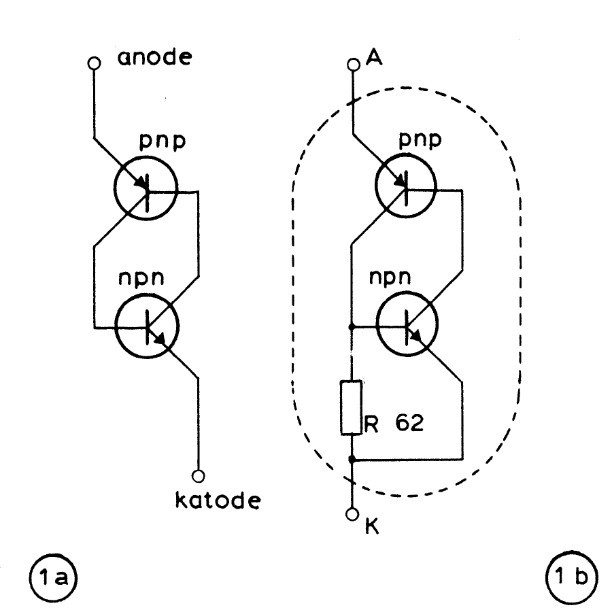
Now, if you think you can get away with just hooking up any old pnp and npn transistor to mimic the effect of a real pnpn diode (1a), you’ll find that the circuit remains stuck in one state and will not auto-ambulate like the real thing. So Elektuur adds just one resistor as a kind of feedback device and voilà. Really? The “equivalent” (1b) will work, but as a very slow device only with serious aberrations in the forward and reverse currents passing between A and K. The little article has done its job though: satisfying curiosity and inducing active thinking and experimenting in the one hand, and insinuating that it's all way too expensive and the Americans are braggers!
Editor's Note: More on Electronics
This article orginally appeared in the special November 2021 edition of Elektor. The issue, which celebrates 60 years of electronics and Elektor, features in-depth articles and interviews about many of the key electronics-related innovations that revolutionized the industry since Elektor's launch in 1961.


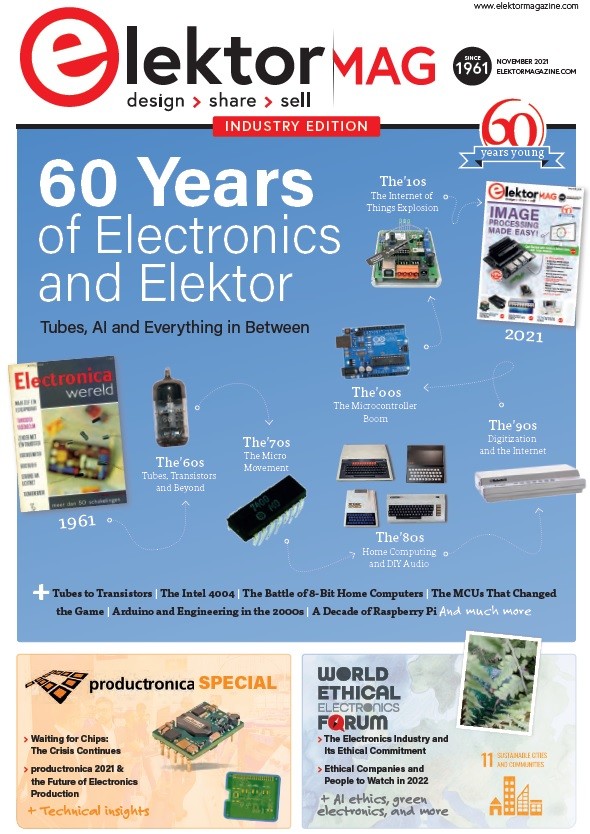
Discussion (0 comments)